Molesey
Hospital
High Street, West Molesey, Surrey
KT8 2LU
Medical
dates:
Medical
character:
Acute. Later, G.P.
The East and West Molesey and
Hampton Court Cottage Hospital opened in May 1890 in Waverley Cottage, 19 Manor Road,
backing onto the Methodist Church. It had been founded as a
private
act of charity by the Dowager Lady
Barrow.
In February 1892 Lady Barrow's health was failing and, over 80 years of age, she decided to give up responsibility for the Hospital. A public meeting was called by her son-in-law, Revd V.B. Smyth, vicar of West Molesey, and a Committee was appointed to take over management of the Hospital. The Committee consisted of the incumbents of the three Molesey parishes, the chaplain of Hampton Court Palace, the local General Practitioners (G.P.s) and nine lay members - two from each of the Molesey parishes and three from Hampton Court Palace.
As one of its first acts, the Committee decided to rename the Hospital. It became the East and West Molesey and Hampton Court Nursing Home, on the grounds that it sounded better. However, by 1893, the original name was restored.
As the work of the Hospital increased, the premises became quite inadequate. The Committee searched for a more commodious house. Alliance House, a vacant property at No. 55 Pemberton Road, was leased and, in October 1894, the patients transferred to the new Hospital, which had 5 beds.
In 1897, on the death of a Thames waterman, Tom Tagg, his friends endowed a bed at the Hospital in his memory, thus increasing the bed complement to six. A brass plate commemorating Mr Tagg was placed over the bed. The endowment stated that, whenever possible, preference for use of the bed should be given to watermen or those deriving a living from the River Thames.
Later, a cot for infant patients was added to the bed complement.
By 1910 the premises had again become too small and inadequate for the amount of work. The Committee hoped to build a new hospital at some time in the future, but lacked the funds to do so.
In 1921 the Hospital received a donation of £1,032 to endow a bed from the Committee of the Hampton Court Auxiliary Military Hospital, a temporary military hospital which had closed at the end of the WW1 in 1918. The endowed bed was to be used, whenever possible, for the relatives and dependents of servicemen. An oak plaque was placed on the wall of the Board Room to commemorate the gift.
During the 1920s the nursing and domestic staff consisted of a Matron, a nurse or probationer, a maid and a cook-general.
In 1925 each bed was equipped with a bedside wireless set (radio), which had been made possible by an anonymous donor, who not only supplied the equipment but also apparently carried out its installation (presumably also anonymously).
In January 1927 the owner of the building, Mrs Margaret Fuller, died. She left the freehold of Alliance House to the Hospital Trustees in memory of her late husband, James. (A bronze plaque commemorating her gift was later affixed to the wall of the present Hospital).
The Committee had revived its ambitions to build a new hospital, but attempts to buy a site were thwarted by local house owners, who objected to the scheme.
In 1933, following a reorganisation of local government, Esher Council decided that the old Isolation Hospital in the High Street, West Molesey, was redundant. In 1936 the Committee for the Cottage Hospital entered into negotiations to buy the property and its 4 acres of grounds. The Council agreed to sell it for just over £900, a greatly undervalued price.
Although not in an ideal location (being an isolation hospital, it was in a remote area difficult to access), the premises were much larger.
The sale of the Pemberton Road property enabled the Committee to alter and refit the buildings. A modern operating theatre was installed, and covered passageways were added to connect the former isolation ward blocks and the other buildings.
The newly renamed Molesey Cottage Hospital was officially opened in February 1936 by Lady Firth, wife of the steel magnate Sir William Firth. The ceremony had almost had to be postponed when fire broke out in the west wing the week before. It was quickly subdued, however, with only a small area damaged.
The Hospital had 20 beds for adult patients, 3 for children and 4 rooms for private patients. It also had a Nurses' Home.
In 1948 the Hospital joined the NHS with 25 beds under the control of the Kingston Group Hospital Management Committee, part of the South West Metropolitan Regional Hospital Board. It became known simply as the Molesey Hospital.
By 1954 it was a G.P. hospital with 23 beds. Once located in a remote place, it was now surrounded by housing estates. Once more, the facilities had become inadequate. The wards, particularly the male and children's, were very crowded. The Hospital had an operating theatre, an X-ray Department (Matron took the X-rays) and a Minor Casualty Unit (patients involved in road traffic accidents were taken to Kingston Hospital). One room served as an Out-Patients Department, but the Management Committee was considering converting the former A.R.P. Centre into a new Out-Patients and X-ray Department.
Following a major reorganisation of the NHS in 1974, the Hospital came under the administration of the Kingston and Esher District Health Authority, part of the South West Thames Regional Health Authority.
By 1990 it had become a G.P. hospital with 28 beds.
In 1994, after another major reorganisation of the NHS in 1991 and the introduction of the 'marketplace' system of purchaser and provider, the Hospital came under the control of the South Thames Regional Health Authority Community Unit, part of the Kingston and District NHS Trust. It had 26 beds.
By 2005 it had come under the auspices of the East Elmbridge and Mid Surrey Primary Care Trust (PCT), who closed 10 beds in an effort to save money (as it was facing a £6m overspend). The Hospital then had 18 beds.
In 2006, after all the PCTs in Surrey had merged to form the Surrey PCT, the Hospital was threatened with closure as being a 'non-viable' unit as it was not large enough. However, public outrage averted the threat.
In February 1892 Lady Barrow's health was failing and, over 80 years of age, she decided to give up responsibility for the Hospital. A public meeting was called by her son-in-law, Revd V.B. Smyth, vicar of West Molesey, and a Committee was appointed to take over management of the Hospital. The Committee consisted of the incumbents of the three Molesey parishes, the chaplain of Hampton Court Palace, the local General Practitioners (G.P.s) and nine lay members - two from each of the Molesey parishes and three from Hampton Court Palace.
As one of its first acts, the Committee decided to rename the Hospital. It became the East and West Molesey and Hampton Court Nursing Home, on the grounds that it sounded better. However, by 1893, the original name was restored.
As the work of the Hospital increased, the premises became quite inadequate. The Committee searched for a more commodious house. Alliance House, a vacant property at No. 55 Pemberton Road, was leased and, in October 1894, the patients transferred to the new Hospital, which had 5 beds.
In 1897, on the death of a Thames waterman, Tom Tagg, his friends endowed a bed at the Hospital in his memory, thus increasing the bed complement to six. A brass plate commemorating Mr Tagg was placed over the bed. The endowment stated that, whenever possible, preference for use of the bed should be given to watermen or those deriving a living from the River Thames.
Later, a cot for infant patients was added to the bed complement.
By 1910 the premises had again become too small and inadequate for the amount of work. The Committee hoped to build a new hospital at some time in the future, but lacked the funds to do so.
In 1921 the Hospital received a donation of £1,032 to endow a bed from the Committee of the Hampton Court Auxiliary Military Hospital, a temporary military hospital which had closed at the end of the WW1 in 1918. The endowed bed was to be used, whenever possible, for the relatives and dependents of servicemen. An oak plaque was placed on the wall of the Board Room to commemorate the gift.
During the 1920s the nursing and domestic staff consisted of a Matron, a nurse or probationer, a maid and a cook-general.
In 1925 each bed was equipped with a bedside wireless set (radio), which had been made possible by an anonymous donor, who not only supplied the equipment but also apparently carried out its installation (presumably also anonymously).
In January 1927 the owner of the building, Mrs Margaret Fuller, died. She left the freehold of Alliance House to the Hospital Trustees in memory of her late husband, James. (A bronze plaque commemorating her gift was later affixed to the wall of the present Hospital).
The Committee had revived its ambitions to build a new hospital, but attempts to buy a site were thwarted by local house owners, who objected to the scheme.
In 1933, following a reorganisation of local government, Esher Council decided that the old Isolation Hospital in the High Street, West Molesey, was redundant. In 1936 the Committee for the Cottage Hospital entered into negotiations to buy the property and its 4 acres of grounds. The Council agreed to sell it for just over £900, a greatly undervalued price.
Although not in an ideal location (being an isolation hospital, it was in a remote area difficult to access), the premises were much larger.
The sale of the Pemberton Road property enabled the Committee to alter and refit the buildings. A modern operating theatre was installed, and covered passageways were added to connect the former isolation ward blocks and the other buildings.
The newly renamed Molesey Cottage Hospital was officially opened in February 1936 by Lady Firth, wife of the steel magnate Sir William Firth. The ceremony had almost had to be postponed when fire broke out in the west wing the week before. It was quickly subdued, however, with only a small area damaged.
The Hospital had 20 beds for adult patients, 3 for children and 4 rooms for private patients. It also had a Nurses' Home.
In 1948 the Hospital joined the NHS with 25 beds under the control of the Kingston Group Hospital Management Committee, part of the South West Metropolitan Regional Hospital Board. It became known simply as the Molesey Hospital.
By 1954 it was a G.P. hospital with 23 beds. Once located in a remote place, it was now surrounded by housing estates. Once more, the facilities had become inadequate. The wards, particularly the male and children's, were very crowded. The Hospital had an operating theatre, an X-ray Department (Matron took the X-rays) and a Minor Casualty Unit (patients involved in road traffic accidents were taken to Kingston Hospital). One room served as an Out-Patients Department, but the Management Committee was considering converting the former A.R.P. Centre into a new Out-Patients and X-ray Department.
Following a major reorganisation of the NHS in 1974, the Hospital came under the administration of the Kingston and Esher District Health Authority, part of the South West Thames Regional Health Authority.
By 1990 it had become a G.P. hospital with 28 beds.
In 1994, after another major reorganisation of the NHS in 1991 and the introduction of the 'marketplace' system of purchaser and provider, the Hospital came under the control of the South Thames Regional Health Authority Community Unit, part of the Kingston and District NHS Trust. It had 26 beds.
By 2005 it had come under the auspices of the East Elmbridge and Mid Surrey Primary Care Trust (PCT), who closed 10 beds in an effort to save money (as it was facing a £6m overspend). The Hospital then had 18 beds.
In 2006, after all the PCTs in Surrey had merged to form the Surrey PCT, the Hospital was threatened with closure as being a 'non-viable' unit as it was not large enough. However, public outrage averted the threat.
Present status (May 2008)
The Hospital is still in use as a community hospital owned by Surrey PCT and run by Central Surrey Heath. It provides nurse-led 24-hour in-patient nursing care and rehabilitation services, with a view to enable patients to return home to independent living or with carer support.
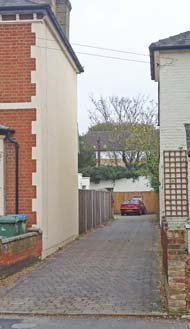
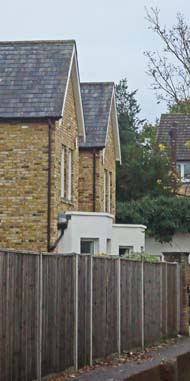
The site of Waverley Cottage, the original location of the Cottage Hospital in Manor Road, is now occupied two detached houses (right) tucked away behind housing on Manor Road (left).

Alliance House at No. 55 Pemberton Road, the second site of the Cottage Hospital, was destroyed by a bomb during WW2. A new house was built in its place after the war.

The entrance drive of the current Hospital with the main building on the left.
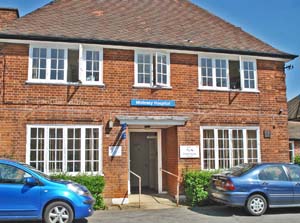
The main building.
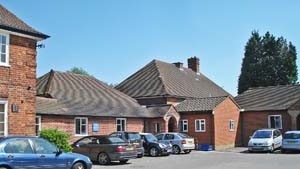
Various smaller buildings containing the wards are located around the central courtyard (above and below).

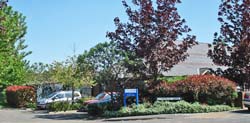
Wesley Lodge in Waverley Close, adjacent to the Hospital, is a residential care home with 8 places for adults who need nursing care.
(Author unstated) 1895 Posts vacant. The Nursing Record, 14th December, 1.
Baker RGM 1981 The story of Molesey Hospital. Self-published.
www.british-history.ac.uk
www.getsurrey.co.uk (1)
www.getsurrey.co.uk (2)
www.getsurrey.co.uk (3)
www.moleseyhistory.co.uk
www.moleseyhistorysociety.org.uk
www.surreyinformationpoint.org.uk
Return to home page